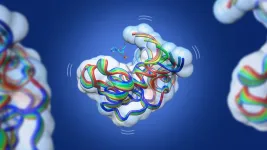(Press-News.org) These health impacts affected communities in states with high oil and gas production, as well as states with limited or no gas activity, underlining the need for comprehensive regulatory action to protect Americans from the pollutants generated by this sector.
Despite global efforts to transition from fossil fuels to clean energy, oil and gas (O&G) production is nearing record levels in the United States, posing concern among health experts about what this O&G growth means for air quality and human health. While there is extensive research on the climate effects of O&G-produced methane—a key contributor to air pollution—few studies have measured the health effects of the air pollution that O&G activity generates.
A new study led by Boston University School of Public Health (BUSPH), the University of North Carolina Institute for the Environment (UNC-IE), PSE Healthy Energy, and Environmental Defense Fund fills this gap.
Published in the journal Environmental Research: Health, the study found that air pollution from the oil and gas sector in the United States has substantial adverse impacts on air quality, human health, and health costs.
The findings show that the pollutants nitrogen oxide (NO2), fine particulate matter (PM2.5) and ozone (O3) from U.S. oil and gas production contributed to 7,500 excess deaths, 410,000 asthma attacks, and 2,200 new cases of childhood asthma across the U.S. in 2016. Factoring in related respiratory and cardiovascular-related hospitalizations, adverse pregnancy outcomes, and other health challenges, oil and gas production was responsible for $77 billion in annual health costs. Comparatively, this total is three times the estimated climate impact costs of methane emissions from oil and gas operations.
These impacts were largely concentrated in areas with significant oil and gas production, such as southwest Pennsylvania, Texas, and Eastern Colorado. But the health effects also extended into densely populated cities with little or no gas activity, such as Chicago, New York City, Baltimore, Washington DC, and Orlando.
The study results suggest that O&G emissions reduction policies, such as the forthcoming EPA methane regulations, may produce immediate and significant air quality benefits to human health along with significant climate benefits. The researchers urge policymakers to consider these “co-benefits” in future emissions reduction strategies. They also stress that strategies that focus on end-of-pipe pollution controls during combustion—such as in power plants, vehicles, buildings, and industry—are only addressing part of the problem.
“These substantial impacts from oil and gas production show that there are serious consequences across the full life cycle of oil and gas, from ‘well to wheels,’ ‘well to power plant,’ and ‘well to furnace,’” says study corresponding author Jonathan Buonocore, assistant professor of environmental health at BUSPH. “The health impacts are not just from the combustion of oil and gas. In order for energy, air quality, and decarbonization policies to successfully protect health, they need to incorporate health impacts across this full life cycle.”
The five states with the highest impacts from O&G pollution were Texas, Pennsylvania, Ohio, Oklahoma, and Louisiana were those with significant oil and gas activity. However, Illinois and New York—states that produce very little O&G—still landed in the 6th and 8th spots.
“The fact that air pollution and health impacts cross state boundaries indicates a strong need for regional to nationwide coordination,” says study senior author Saravanan Arunachalam, research professor at UNC-IE. “States that have the highest emissions are not necessarily always the ones with the highest health risk due to these emissions, although Texas ranks first in both.”
A novelty of this modeling framework is the inclusion of health impacts of NO2, and the use of an advanced model that better captures the chemistry of emissions from the oil & gas sector. Among the three pollutants, NO2 was the highest contributor to the overall health impacts, producing 37 percent of these effects, followed by ozone at 35 percent, and PM2.5 at 28 percent. The vast majority of these effects pertained to mortality. NO2 contributes to the formation of PM2.5 and ozone, so strategies to reduce O&G-produced NO2 could be effective in reducing health impacts. State regulations addressing precursor NO2 emissions from the oil and gas sector could help mitigate childhood asthma cases for communities living in proximity to the emission sources, and provide secondary ozone and PM2.5 health benefits in downwind areas.
“Curbing oil and gas emissions is one of the fastest, most cost-effective ways to reduce methane and other air pollutants, which improves air quality, protects public health and slows climate change,” says study co-author Ananya Roy, senior health scientist at EDF. “It’s critical that the U.S. Environmental Protection Agency strengthen and finalize its proposed oil and gas methane rules as quickly as possible. These proposed rules should build from leading state approaches in Colorado and New Mexico and go further to end pollution from the practice of routine flaring.”
The authors say future studies should focus on learning more about health impacts across the full life cycle of O&G production, as well as the benefits of additional O&G pollution control strategies.
“There are technologies and strategies to reduce methane leaks, emissions from compressor stations, or emissions from other sources, such as ponds and dehydrators,” Buonocore says. “Each of these strategies will have different effects on the levels of different pollutants that get emitted.”
There is also more work to be done to quantify the health impacts of emissions that the study did not examine, such as benzene and formaldehyde, Arunachalam notes. “Exposure to these pollutants which have been detected near oil and gas wells can cause cancer and several other adverse health impacts, and quantifying them will demonstrate even higher public health benefits of controlling emissions from this sector.”
**
About Boston University School of Public Health
Founded in 1976, Boston University School of Public Health is one of the top five ranked private schools of public health in the world. It offers master's- and doctoral-level education in public health. The faculty in six departments conduct policy-changing public health research around the world, with the mission of improving the health of populations—especially the disadvantaged, underserved, and vulnerable—locally and globally.
END
Air pollution from oil and gas production responsible for $77 billion in annual US health damages, contributes to thousands of early deaths, childhood asthma cases nationwide
These health impacts affected communities in states with high oil and gas production, as well as states with limited or no gas activity, underlining the need for comprehensive regulatory action to protect Americans from pollutants.
2023-05-08
ELSE PRESS RELEASES FROM THIS DATE:
A sharp increase in the price of the gout drug colchicine led to lower use and poorer disease control, UCLA research suggests
2023-05-08
FINDINGS
Due to a policy decision in 2010 by the U.S. Food and Drug Administration (FDA), the price of a prescription for the therapeutic gout drug colchicine increased nearly 16-fold from $11.25 in 2009 to $190.49 in 2011. Out-of-pocket costs for patients who took the drug jumped more than four-fold from $7.37 to $39.49 over the same period. Use of colchicine dropped 17% during this time and 27% over the following decade. Patients turned to alternative medications for gout such as allopurinol and corticosteroids. However, disease ...
An unprecedented view of gene regulation
2023-05-08
CAMBRIDGE, MA -- Much of the human genome is made of regulatory regions that control which genes are expressed at a given time within a cell. Those regulatory elements can be located near a target gene or up to 2 million base pairs away from the target.
To enable those interactions, the genome loops itself in a 3D structure that brings distant regions close together. Using a new technique, MIT researchers have shown that they can map these interactions with 100 times higher resolution than has previously been possible.
“Using this method, we generate the highest-resolution maps of the 3D genome that have ever been generated, and what we see are a lot of interactions between ...
AI helps create better, simpler hepatitis, COVID-19 tests
2023-05-08
Going beyond pregnancy and COVID-19, the world could someday soon come to rely on at-home tests for many diseases thanks in part to AI-fueled improvements.
University of Florida scientists have used artificial intelligence tools to simplify a test that works for both hepatitis C and SARS-CoV-2, the virus that causes COVID-19. The simplified test happens in one small test tube in just a few minutes. With further refinement, it could come to doctor’s offices soon and, one day, even home tests that are as easy as a pregnancy test.
“We are trying to build a home-based test that is as reliable as a lab-based test,” said Piyush ...
Leaky-wave metasurfaces: A perfect interface between free-space and integrated optical systems
2023-05-08
New York, NY—May 8, 2023—Researchers at Columbia Engineering have developed a new class of integrated photonic devices--“leaky-wave metasurfaces”--that can convert light initially confined in an optical waveguide to an arbitrary optical pattern in free space. These devices are the first to demonstrate simultaneous control of all four optical degrees of freedom, namely, amplitude, phase, polarization ellipticity, and polarization orientation--a world record. Because the devices are so thin, transparent, and compatible with photonic integrated circuits ...
AI predicts future pancreatic cancer
2023-05-08
An artificial intelligence tool has successfully identified people at the highest risk for pancreatic cancer up to three years before diagnosis using solely the patients’ medical records, according to new research led by investigators at Harvard Medical School and the University of Copenhagen, in collaboration with VA Boston Healthcare System, Dana-Farber Cancer Institute, and the Harvard T.H. Chan School of Public Health.
The findings, published May 8 in Nature Medicine, suggest that AI-based population screening could be valuable in finding those at elevated risk for the disease and could expedite the diagnosis of a condition ...
Tiny microbes could brew big benefits for green biomanufacturing
2023-05-08
A research team led by Lawrence Berkeley National Laboratory (Berkeley Lab) and UC Berkeley has engineered bacteria to produce new-to-nature carbon products that could provide a powerful route to sustainable biochemicals.
The advance – which was recently announced in the journal Nature – uses bacteria to combine natural enzymatic reactions with a new-to-nature reaction called the “carbene transfer reaction.” This work could also one day help reduce industrial emissions because it offers sustainable ...
Human Brain Project: Study presents large brain-like neural networks for AI
2023-05-08
In a new study in Nature Machine Intelligence*, researchers Bojian Yin and Sander Bohté from the HBP partner Dutch National Research Institute for Mathematics and Computer Science (CWI) demonstrate a significant step towards artificial intelligence that can be used in local devices like smartphones and in VR-like applications, while protecting privacy. They show how brain-like neurons combined with novel learning methods enable training fast and energy-efficient spiking neural networks on a large scale. Potential applications range from wearable AI to speech recognition and Augmented Reality.
While modern artificial neural ...
Detailed image of the human retina
2023-05-08
What cell types are found in which human tissue, and where? Which genes are active in the individual cells, and which proteins are found there? Answers to these questions and more are to be provided by a specialised atlas – in particular how the different tissues form during embryonic development and what causes diseases. In creating this atlas, researchers aim to map not only tissue directly isolated from humans, but also structures called organoids. These are three-dimensional clumps of tissue that are cultivated in the laboratory and develop in a way similar ...
Welcoming Dr Ece Uzun, MS, PhD as the Editor-in-Chief for JMIR Bioinformatics and Biotechnology
2023-05-08
JMIR Bioinformatics and Biotechnology and JMIR Publications are thrilled to announce and welcome Dr Ece Uzun as Editor-in-Chief for JMIR Bioinformatics and Biotechnology.
Dr. Uzun is currently the Director of Clinical Bioinformatics and Associate Director of Clinical Cancer Informatics and Data Science (CCIDS) at Lifespan and an Assistant Professor of Pathology and Laboratory Medicine at Brown University Alpert Medical School. She has a B.S in Chemical Engineering and M.Sc in Biological Sciences and Bioengineering. She completed her PhD in Chemical Engineering at Northeastern University in 2010 and focused ...
Elucidating the mysteries of enzyme evolution at the macromolecular level
2023-05-08
Professor Nicolas Doucet and his team at Institut national de la recherche scientifique (INRS) made a major breakthrough earlier this year in the field of evolutionary conservation of molecular dynamics in enzymes. Their work, published in the journal Structure, points to potential applications in health, including the development of new drugs to treat serious diseases such as cancer or to counter antibiotic resistance.
As a researcher specializing in protein dynamics, Professor Doucet is captivated by things that are invisible to the naked eye, yet full of mysteries and essential to all forms of life. He studies proteins ...
LAST 30 PRESS RELEASES:
Making lighter work of calculating fluid and heat flow
Normalizing blood sugar can halve heart attack risk
Lowering blood sugar cuts heart attack risk in people with prediabetes
Study links genetic variants to risk of blinding eye disease in premature infants
Non-opioid ‘pain sponge’ therapy halts cartilage degeneration and relieves chronic pain
AI can pick up cultural values by mimicking how kids learn
China’s ecological redlines offer fast track to 30 x 30 global conservation goal
Invisible indoor threats: emerging household contaminants and their growing risks to human health
Adding antibody treatment to chemo boosts outcomes for children with rare cancer
Germline pathogenic variants among women without a history of breast cancer
Tanning beds triple melanoma risk, potentially causing broad DNA damage
Unique bond identified as key to viral infection speed
Indoor tanning makes youthful skin much older on a genetic level
Mouse model sheds new light on the causes and potential solutions to human GI problems linked to muscular dystrophy
The Journal of Nuclear Medicine ahead-of-print tip sheet: December 12, 2025
Smarter tools for peering into the microscopic world
Applications open for funding to conduct research in the Kinsey Institute archives
Global measure underestimates the severity of food insecurity
Child survivors of critical illness are missing out on timely follow up care
Risk-based vs annual breast cancer screening / the WISDOM randomized clinical trial
University of Toronto launches Electric Vehicle Innovation Ontario to accelerate advanced EV technologies and build Canada’s innovation advantage
Early relapse predicts poor outcomes in aggressive blood cancer
American College of Lifestyle Medicine applauds two CMS models aligned with lifestyle medicine practice and reimbursement
Clinical trial finds cannabis use not a barrier to quitting nicotine vaping
Supplemental nutrition assistance program policies and food insecurity
Switching immune cells to “night mode” could limit damage after a heart attack, study suggests
URI-based Global RIghts Project report spotlights continued troubling trends in worldwide inhumane treatment
Neutrophils are less aggressive at night, explaining why nighttime heart attacks cause less damage than daytime events
Menopausal hormone therapy may not pose breast cancer risk for women with BRCA mutations
Mobile health tool may improve quality of life for adolescent and young adult breast cancer survivors
[Press-News.org] Air pollution from oil and gas production responsible for $77 billion in annual US health damages, contributes to thousands of early deaths, childhood asthma cases nationwideThese health impacts affected communities in states with high oil and gas production, as well as states with limited or no gas activity, underlining the need for comprehensive regulatory action to protect Americans from pollutants.




